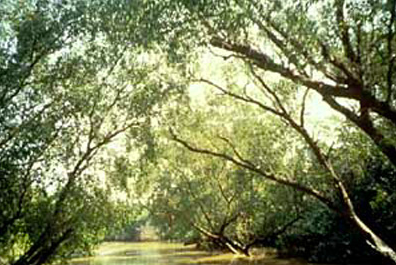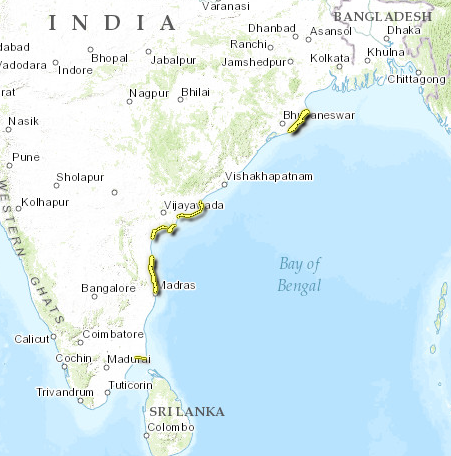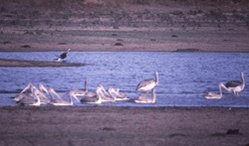Goadavari-Krishna mangroves

Coastal Orissa, India. (Photograph by Alfredo Quarto, Mangrove Action Project)
Introduction The Godavari-Krishna Mangroves provide a critical buffer between the marine and terrestrial (Goadavari-Krishna mangroves) ecosystems along the eastern coast of the Indian subcontinent, especially at the estuaries formed by the Godavari and Krishna rivers, which originate in the Western Ghats and run right across the vast Deccan Plateau.
Location and General Description
The ecoregion extends along the [[coast]line] as narrow disjunct patches but forms larger habitat blocks in the estuaries of Godavari and Krishna rivers in the states of Orissa and Andhra Pradesh, respectively. Mangrove [[ecoregion]s] are not exceptionally rich, but their importance should not be based solely on their species richness. Mangroves play a critical ecological role as a transition habitat from the marine to freshwater and terrestrial systems. They also provide important habitat for numerous species of fishes and crustaceans that are adapted to live and reproduce among the tangled mass of mangrove roots. The juvenile stages of many of these species depend on these mangroves for refuge and survival.
The mangrove vegetation is influenced by tidal fluctuations and salinity patterns. They are not diverse compared with most of the other terrestrial ecosystems. Undisturbed forests have a dense, unstratified canopy. The undergrowth is made up of seedlings and saplings from the canopy trees. The characteristic flora of these mangroves includes Avicennia marina, Suaeda spp., Rhizophora spp., and Bruguiera spp. Other species such as Avicennia officinalis, Aegiceras corniculatum, Ceriops, Lumnitzera racemosa, and Excoecaria agallocha are less common. Climbers such as Derris trifoliata and Dalbergia spinosa, undershrubs of Suaeda spp. and Acanthus ilicifolius and, very rarely, Sonneratia apetala, Xylocarpus mekongensis, Salicornia brachiata, Arthrocnemum indicum, and Sesuvium portulacastrum provide additional structure to these forests.
Biodiversity Features
This mangrove ecoregion provides critical habitat for many species of vertebrates and invertebrates, and is an important spawning ground and nursery for fish fry, shrimp, crabs, and other invertebrates. Crocodiles (Crocodylus spp.), monitor lizards (Varanus spp.), and various snake species forage for smaller lizards and other prey. Hermit crabs, fiddler crabs, and mudskippers take refuge in the spaces among the tangle of mangrove roots from egrets and other wading birds that hunt them.
The ecoregion harbors more than 140 bird species, including the globally threatened lesser florican (Eupodotis indica) and a large community of aquatic birds that includes flamingoes (Phoenicoptreus spp.), spot-billed pelicans (Pelecanus philippensis), spoonbills (Platalea spp.), and painted storks (Mycteria leucocephala). The Godavari-Krishna Mangroves provide a critical buffer between the marine and terrestrial ecosystems along the eastern coast of the Indian subcontinent, especially at the estuaries formed by the Godavari and Krishna rivers, which originate in the Western Ghats and run right across the vast Deccan Plateau.
Current Status
More than 90 percent of this [[ecoregion]'s] natural habitat has been destroyed. Three small protected areas cover a mere 930 km2 (table 1). Although this represents about 14 percent of the ecoregion's area, most of the protected areas are degraded.
|
Table 1. Protected Areas That Overlap with the Ecoregion. Protected Area Area (km2) IUCN Category Point Calimere 250 IV Pulicat Lake 640 IV Bhitar Kanika 40 IV Total 930 (Goadavari-Krishna mangroves) Types and Severity of ThreatsBecause of continuing threats from human activities, the conservation status of this ecoregion was changed from endangered to critical. Most of the threats stem from clearing the forests for shrimp culture, agriculture, plantations, and urban development. Pollution from urban and agricultural runoff exerts great stresses on this delicate ecosystem and on the juvenile stages of many species of fishes and invertebrates that use the mangroves as nurseries and are highly susceptible to changes in environmental quality. Other threats include freshwater diversion for agriculture that prevents or reduces the regular flushing within the system, causing the mangroves to become stagnant. Construction of harbors and channels also reduces freshwater flows, thus increasing the salinity beyond the tolerance levels of the floral and faunal communities.
Additional information on this ecoregion
<center>
CitationFund, W. (2014). Goadavari-Krishna mangroves. Retrieved from http://editors.eol.org/eoearth/wiki/Goadavari-Krishna_mangroves |
|||

